1 - Anatomy of the Thorax
Editors: Shields, Thomas W.; LoCicero, Joseph; Ponn, Ronald B.; Rusch, Valerie W.
Title: General Thoracic Surgery, 6th Edition
Copyright 2005 Lippincott Williams & Wilkins
> Table of Contents > Volume I - The Lung, Pleura, Diaphragm, and Chest Wall > Section I - Anatomy of the Chest Wall and Lungs > Chapter 3 - Ultrastructure and Morphometry of the Human Lung
function show_scrollbar() {}
Chapter 3
Ultrastructure and Morphometry of the Human Lung
Peter H. Burri
Juan Gil
Ewald R. Weibel
ORGANIZATION OF THE LUNG
The application of electron microscopy and quantitative methods in morphology (morphometry) has widened the general understanding of lung structure and set the course for a more functional approach to the study of pulmonary architecture. It cannot be the aim of this chapter, however, to cover all aspects of lung microanatomy; in this respect, the reader is referred to the specialized literature. We would rather present the morphologic and quantitative background needed to understand the functioning of the gas-exchange apparatus.
The lung is composed of three phases: air, tissue, and blood. The tissue forms a complete barrier between air and blood; it is a stable structural framework, whereas air and blood are continuously exchanged. In describing the ultrastructure of the lung, we emphasize the specializations of the tissue in forming boundary spaces for air and blood. Morphometry deals with the quantitative relations among these three phases.
From the functional point of view, the organization of the lung may be defined in relation to the hierarchy of airways and blood vessels, from the trachea down to alveoli, or from the main stem of the pulmonary artery through the capillary network to the pulmonary veins entering the left atrium.
All of this is jointly considered in the scheme of Fig. 3-1. Besides showing the three phases, the diagram introduces the three major functional zones of the lung: first, the conductive zone, consisting of air channels and blood vessels, the function of which is to guide and distribute air and blood into the peripheral lung units; second, the respiratory zone, composed of alveoli and capillaries; and third, the intermediate or transitory zone, containing elements of both.
FINE STRUCTURE OF THE LUNG
Fine Structure of Conducting Airways
The conducting airways are a system of tubes that multiply toward the periphery by division according to the principle of irregular dichotomy. From the trachea to bronchi to bronchioles, the structure of the airway gradually changes. Common to all is the general scheme of a three-layered wall made of a mucosa, a muscle layer, and a connective tissue sheath (Fig. 3-2) and the presence of a typical ciliated epithelium, which we describe first.
Lining Epithelium of Conductive Airways
The inspired air must be humidified and warmed before it reaches the delicate gas-exchange area; furthermore, air pollutants and dust, as well as airborne microorganisms, must be removed. Although the upper respiratory tract, in particular the nasal portion, is especially designed for these functions, the respiratory epithelium (Fig. 3-3), of all conducting airways, shows special features for the handling of airborne particles. The respiratory epithelium is a ciliated pseudostratified columnar epithelium with numerous scattered goblet cells. Ciliated cells occur from the trachea down to the last respiratory bronchiole, but their height decreases with the reduction of the airway diameter; ciliated cells of the trachea are columnar (Fig. 3-4), whereas those of the respiratory bronchioles are cuboidal (Fig. 3-5). The frequency of goblet cells also decreases toward the periphery; in bronchioles, they are replaced by Clara cells (see Fig. 3-5). These are complex exocrine cells known to be equipped with active cytochrome P-450 metabolic pathways capable of actively participating in the detoxification of foreign substances. Understanding the nature of their secretory function has proved
P.30
more difficult. Dierynck (1995), Hermans (1998), and Yao (1998a, 1998b) and their colleagues have reported the presence of small (10, or in particular, 16 kDa) Clara cell proteins thought to be powerful immunosuppressants or antiinflammatory substances active in the modulation of inflammatory responses. Cytologic, kinetic, and histochemical studies by Breeze and Wheeldon (1977), Jeffery and Reid (1977), and Jeffery (1983), as well as Spicer (1983), St. George (1985), and Plopper (1991) and their colleagues, have provided insights into the cell types of the airway epithelium of various species, including humans. In investigations, great emphasis also has been put on the neuroendocrine cells interspersed in the epithelium, often called Feyrter, Kulchitsky, amine precursor uptake and decarboxylation (APUD), or small granule cells. These neuroendocrine cells are present in the respiratory tract of all vertebrate species investigated so far. Lauweryns and Cokelaere (1973) found the neuroendocrine cells thinly scattered along the airways, either isolated or clustered in neuroepithelial bodies. Neuroepithelial bodies are assumed to function as chemoreceptors; they may act on pulmonary vascular or airway smooth muscle by secreting vasoactive substances. Sorokin and co-workers (1983) found them to
P.31
represent a heterogeneous population of cells, and according to investigations by Hoyt and co-workers (1990) in the hamster lung, they are no more considered to be of neural crest origin.
The frequently found basal cells represent a proliferative pool of undifferentiated cells that are thought to replace the overlying cells on differentiation and maturation. Less common are the brush cells and migratory cells. Finally, we should mention the occurrence of naked nerve endings between individual cells, more frequent in the trachea and large bronchi. They are thought to be irritant receptors.
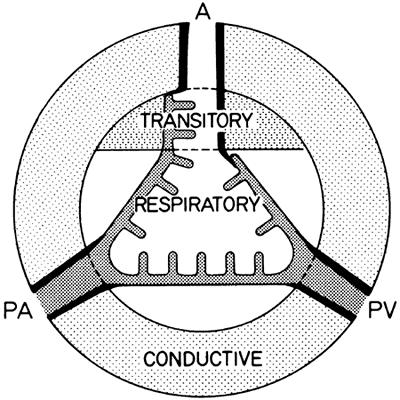 |
Fig. 3-1. Schematic representation of lung zones. A, airways; PA, pulmonary artery; PV, pulmonary vein. |
 |
Fig. 3-2. Structure of bronchi and bronchioles. 1, Mucosa with epithelium and elastic fibers; 2, smooth muscle layer; 3, fibrous layer contains cartilage (C) in the bronchi; 4, peribronchial sheath of loose connective tissue. |
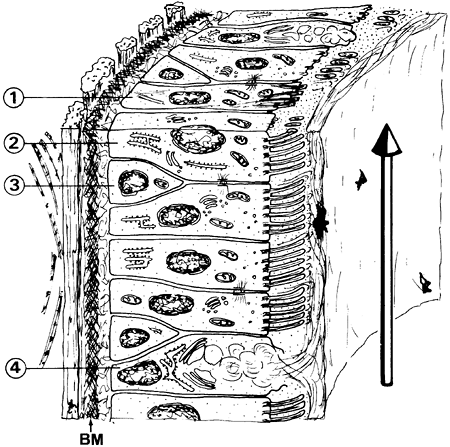 |
Fig. 3-3. Pseudostratified epithelium of bronchus with brush (1), ciliated (2), basal (3), and goblet cells (4). The cilia beat in a serous fluid that is topped by a mucous layer secreted partly by goblet cells. A strong basement membrane (BM) and a layer of longitudinal elastic fibers form the basis of the epithelium. |
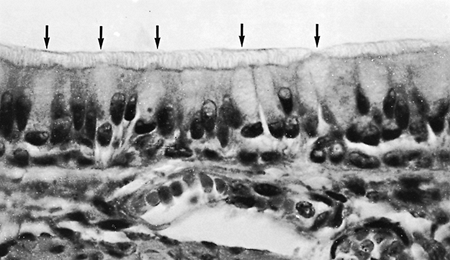 |
Fig. 3-4. Pseudostratified epithelium from bronchus. Note goblet cells (arrows) (600 magnification). |
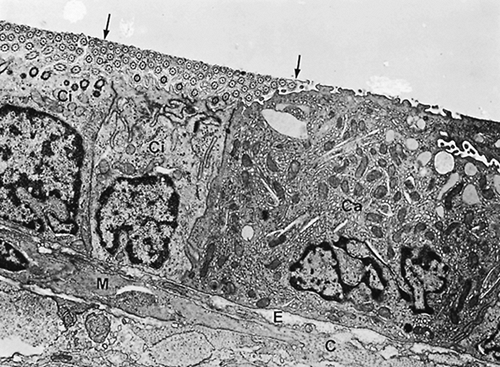 |
Fig. 3-5. Electron micrograph of bronchiolar wall with simple cuboidal epithelium made up of ciliated cells (Ci) and Clara cells (Ca). In place of the mucous layer is a fine osmiophilic film (arrows) at the air liquid interface. A smooth muscle cell (M) and collagenous (C) and elastic (E) fibers are seen in the subepithelial tissue. Rat lung fixed by vascular perfusion (9,200 magnification). |
Figure 3-3 shows a schematic representation of a portion of the respiratory epithelium of a bronchus. The function of this epithelium is to capture airborne particles in a sticky mucous layer and to remove them efficiently from the lung. For this purpose, cilia show a synchronized rhythmic beat within a thin layer of low-viscosity fluid. On top, a blanket of mucus is moved in the direction of the pharynx, carrying intercepted particles. This cleaning mechanism can be compared with a conveyor belt and is often called the mucociliary escalator. The mechanism of mucus propulsion has been described in detail by Sleigh (1991). The mucous layer is secreted onto the epithelial surface by goblet cells and by seromucous glands located in the walls of trachea and bronchi (see Fig. 3-2). The small bronchioles are most likely devoid of mucus because their wall contains neither goblet cells nor glands. As two of us (JG and ERW) have shown (1971), their surface is formed by a fluid layer of low viscosity that is sometimes topped by a thin osmiophilic film. Finally, the presence in the bronchial secretion of several humoral agents, which would protect the airways against infections, has been reported.
Trachea and Bronchi
Trachea and bronchi are characterized by the presence of cartilage within the fibrous sheath of their walls (see Fig. 3-2). In the trachea and stem bronchi, the cartilage is in the form of incomplete rings; in the trachea, these cover the ventral and lateral aspects, whereas the dorsal wall contains a strong layer of transverse smooth muscle. After about the second or third generation, these rings are gradually replaced by irregular cartilage plates, and a layer of smooth muscle appears between mucosa and cartilage.
All conducting airways are surrounded by an external, loose connective tissue sheath (see Fig. 3-2), which is continuous with the other connective elements of the lung. It is a structure of considerable physiologic significance because it contains bronchial vessels to supply the bronchial wall with blood from the systemic circulation, as well as nerves and lymphatic vessels. Only a small part of the arterial bronchial flow, in some species as little as 25%, is drained by the bronchial veins. Most of it goes into the peribronchial venous plexus and from there into the pulmonary veins, forming a small right-to-left shunt. The bronchus is accompanied usually by a branch of the pulmonary artery, which is enveloped by connective tissue continuous with the peribronchial sheath.
Lymphatic vessels contained in these peribronchial and perivascular sheaths, as well as in the subpleural and septal connective tissue, constitute the main drainage path for the interstitial fluid.
Bronchioles
A bronchiole is an airway devoid of cartilage and seromucous glands; goblet cells are rare. Because airway structure does not change abruptly, either seromucous glands or goblet cells may still be present in transitional zones. Bronchioles are rather small conducting airways, measuring about 1 mm or less in diameter. Their added cross-sectional area is such, however, that they are not supposed to contribute substantially to the flow resistance of the airways in the normally breathing healthy individual. Their walls are generally thin and molded into the surrounding parenchyma. They are supplied with blood from the lesser circulation, rather than from bronchial arteries. The bronchiolar mucosa is lined by a simple cuboidal epithelium (see Fig. 3-5) composed of ciliated cells and Clara cells, which, as mentioned in the section discussing epithelial properties, have a dual detoxifying and secretory function. They are the object of intense study, and their exocrine secretory activity is being linked with a modulation of the inflammatory and immunologic response to injury. Their position as defensive cells is crucial because in the normal respiratory tidal range, bronchioles are the last conducting airways to receive bulk air in conjunction with inspiration. In bronchioles, Clara cells take the place of goblet cells found in larger airways.
P.32
In bronchioles, the smooth muscle cells form a well-developed, relatively thick layer arranged in a geodesic network, capable of narrowing the airway.
Resistance to Airflow in Conducting Airways
The partition of airflow resistance between large and small airways both in health and disease has been controversial. It is universally accepted that, in the healthy lung, the major site of resistance is the large, central airways, whereas the bronchioles contribute less than 20%, but it is important to know that pathologic increases of resistance always occur in the bronchiolar region. Airflow in the trachea is turbulent; in the bronchioles, it is laminar. In between, it is often referred to as transitional, implying an admixture of both, although experimental studies are difficult to perform. One of the major contributions to the understanding of the pathophysiology of emphysema was the clarification of the mechanisms of early airway closure. A priori examination of the bronchiolar anatomy immediately reveals the factors that account for their active and passive narrowing: smooth muscle, compression by neighboring parenchyma during inflation, and internal surface tension. The elements that counteract the narrowing and act to cause bronchiolar dilation are less evident, however, made possible only by the radial insertion of alveolar walls in their periphery and by the principle of mechanical interdependence. The integrity of alveolar walls is therefore essential in keeping bronchioles open during deflation. In conditions such as emphysema, in which alveolar walls are lost, the loss of bronchiolar support causes a calamitous early collapse of small bronchioles at the onset of expiration, with trapping of air in all areas of the parenchyma located behind the obstruction.
 |
Fig. 3-6. Schematic representation of the sequence of airway branches as a function of generation z. Bronchi (BR), bronchioles (BL), terminal (TBL), and respiratory (RBL) bronchioles are followed by alveolar ducts (AD) and sacs (AS) in the terminal generation. T=23. From Weibel ER: Morphometry of the Human Lung. Heidelberg: Springer, 1963, p. 111. With permission. |
Fine Structure of Transitory Airways
Respiratory Bronchioles
The last generation of exclusively conducting bronchioles is the terminal bronchioles. These branch to form about three generations of respiratory bronchioles (Fig. 3-6), which have essentially the same structure as other bronchioles except that, here and there and increasingly toward the periphery, the continuity of their wall is interrupted by areas of typical gas-exchanging tissue. Contrary to common textbook descriptions, the cuboidal epithelial cells of respiratory bronchioles are in most cases ciliated; short cilia can even be demonstrated in close proximity to alveoli.
Alveolar Ducts and Sacs
The mammalian airways form a blind-ending system. Dichotomy as a branching pattern can be demonstrated up to the last ranks of the airway system, the alveolar ducts and alveolar sacs (see Fig. 3-6). These structures differ from the bronchioles described previously in that they lack a proper wall; instead, their wall is formed by the openings of alveoli (Fig. 3-7), and their epithelial lining is nothing more than extensions of squamous alveolar epithelial cells. It is generally admitted that three generations of alveolar ducts immediately follow the last respiratory bronchioles. Finally, the last ducts give rise to two alveolar sacs. An alveolar sac represents the blind end of the airway branching system.
Fine Structure of the Gas-Exchange Region
In the respiratory zone of the lung, the blood is spread in capillaries in the walls of the alveoli. The air blood contact becomes intimate, and gas exchange can take place.
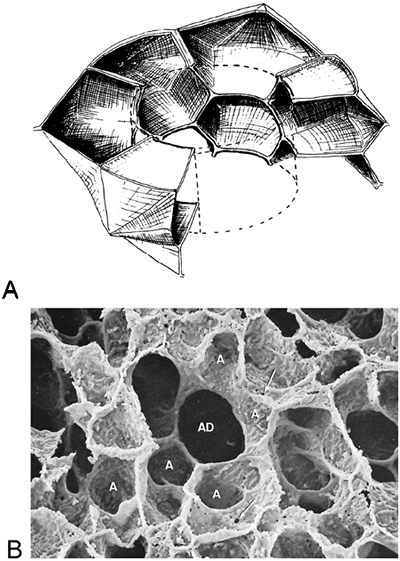 |
Fig. 3-7. A. Schematic representation of arrangement of alveoli around the alveolar duct. From Weibel ER: Morphometry of the Human Lung. Heidelberg: Springer, 1963, p. 57. With permission. B. Scanning electron micrograph of human lung (150 magnification). A, alveoli; AD, alveolar duct; arrows point to pores of Kohn. |
P.33
Alveoli
Alveoli are small pouches placed in groups around respiratory bronchioles, alveolar ducts, and alveolar sacs. They are polyhedral structures lacking one side (the mouth, which opens into the airways), and they have been compared with the cells of a honeycomb (see Fig. 3-7) or with the air bubbles in foam. A polygonal shape in general is economical because it allows a close packing of the alveoli. The studies of Haefeli-Bleuer and one of us (ERW) (1988) on human pulmonary acini revealed that the shape of alveoli is not simple and that often an alveolus appears like a cluster of several connected pouches, as in Fig. 3-7B. Furthermore, alveolar shape also depends on the degree of lung inflation, according to one of use (JG) and co-workers (1979). Only in fully inflated lungs has the alveolar configuration some similarity to the cells of a honeycomb. At lower inflation degrees, alveoli are often cuplike.
The alveolar wall is always common to two adjacent alveoli and is called the alveolar or interalveolar septum (see Fig. 3-7B). The most conspicuous feature of the septum is a single but dense network of capillaries, which is shown in Fig. 3-8 in face view. Sometimes, the septa are interrupted by pores of Kohn, which provide a path of communication between adjoining alveoli. The septa also contain a skeleton of connective tissue fibers that is especially well developed around the mouth of the alveoli, where it forms a polygonal ring (see Fig. 3-7) and may contain smooth muscle fibers. The collagenous and elastic fibrous elements form a three-dimensional continuum that extends from the pleura to the hilus. This continuum ensures transmission of chest and diaphragmatic movements into the deeper regions of the lung, but it contributes only a smaller part to the retracting force of the lung, the major part being caused by surface forces. We (ERW and JG) (1977) and one of us (ERW) (1984) have discussed the arrangement of the connective tissue in detail.
 |
Fig. 3-8. Capillaries in the alveolar wall of the human lung are shown in a scanning electron micrograph (A) and in a model (B). Note the thin tissue barrier separating air and blood (arrow) and fibers (F) interwoven with capillary network (C) (scale marker=10 m). From Weibel ER: The Pathway for Oxygen. Cambridge: Harvard University Press, 1984. With permission. |
 |
Fig. 3-9. Electron micrograph of alveolar capillary (C) from monkey lung with erythrocyte (EC). Note endothelial cell lining of capillary (EN), processes of pericytes (P), and the thin extensions of squamous alveolar epithelial cells (EP) covering the alveolar surface. The interstitial space (IN) is bounded by two basement membranes (BM) and contains some fibroblast processes (FB) as well as a few connective tissue fibrils. This lung was fixed by instillation of fixative into airways, resulting in a loss of the surface lining layer; hence, only parts 2 (tissue barrier), 3 (blood plasma), and 4 (erythrocyte) of the gas exchange pathway are preserved, whereas the first layer, the surface lining layer (Fig. 3-10), is missing (8,600 magnification). From Weibel ER: Morphometric estimation of pulmonary diffusion capacity. I. Model and method. Respir Physiol 11:54, 1970 71. With permission. |
P.34
Alveolocapillary Tissue Barrier
Figure 3-9 shows a section of a small portion of an interalveolar septum with a capillary. The septum is lined on both sides by alveolar epithelial cells, which, in this instance, are thin. The capillary is lined also by a single squamous cell layer, the endothelium. Together with the intercalated connective tissue, these two cell layers constitute the alveolocapillary tissue barrier, which is the structure separating air and blood in the pulmonary gas-exchange region. It is supplemented by an extremely thin extracellular lining layer that contains macrophages (Figs. 3-10 and 3-11). The morphometric characteristics of the cell population that constitutes this tissue barrier in the human lung are shown inTable 3-1.
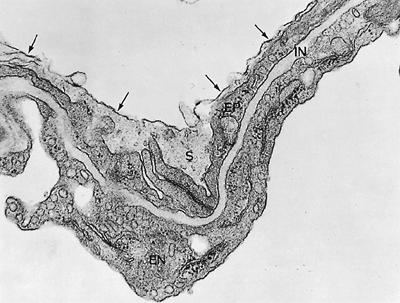 |
Fig. 3-10. Air blood barrier of rat lung fixed by vascular perfusion to preserve surface lining layer (S) made up of base layer and osmiophilic surface film (arrows) (38,700 magnification). EN, endothelial cell lining of capillary; EP, squamous alveolar epithelial cells; IN, interstitial space. From Weibel ER: Morphometric estimation of pulmonary diffusion capacity. Respir Physiol 11:54, 1970 71. With permission. |
Epithelium
The epithelium of the alveoli is continuous, although its thickness in places reaches only 0.1 to 0.3 m, which is at the limit of resolution of the light microscope. The study by Low (1952) brought the first conclusive evidence for an uninterrupted epithelial lining of alveoli. It consists of the following cell types (see Table 3-1).
Alveolar epithelial cells type I (Fig. 3-12), also called squamous cells, send out broad, thin cytoplasmic extensions. Although they are some 30% to 40% less numerous than the
P.35
type II cells, they cover 92% to 95% of the total alveolar surface. The nuclei lie in depressions between two capillaries. These cells are poor in organelles, such as mitochondria or endoplasmic reticulum, which are confined to the perinuclear cytoplasm, whereas the cytoplasmic extensions essentially contain only pinocytotic vesicles. Crapo and associates (1982) found that in humans, a single type I cell covers some 5,000 m2 of the alveolar surface, on the average.
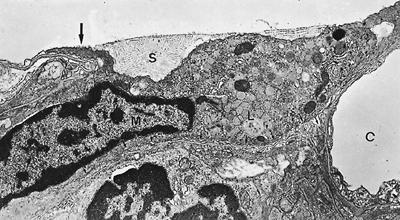 |
Fig. 3-11. Alveolar macrophage (M) with pseudopods and groups of lysosomal vesicles (L) in cytoplasm submerged beneath surface lining layer (S) and closely stuck to the alveolar epithelium (arrows). The base layer of the surface lining layer contains so-called tubular myelin figures. The capillary (C) is empty because of fixation by vascular perfusion (10,500 magnification). From Gil J: Ultrastructure of lung fixed under physiologically defined conditions. Arch Intern Med 127:896, 1971. With permission. |
Table 3-1. Morphometric Characteristics of Cell Population in the Human Alveolar Septal Tissue | |||||||||||||||||||||||||||||||||||||||
|---|---|---|---|---|---|---|---|---|---|---|---|---|---|---|---|---|---|---|---|---|---|---|---|---|---|---|---|---|---|---|---|---|---|---|---|---|---|---|---|
| |||||||||||||||||||||||||||||||||||||||
Alveolar cells type II are cuboidal (Fig. 3-13). These cells also have been called granular pneumocytes, septal cells, alveolar cells, and great alveolar cells, although they are smaller than type I cells. They have no cytoplasmic extensions and typically are in niches between capillaries of the alveolar septum. Their free surface is covered by somewhat irregular microvilli. The cells occupy 5% to 8% of the alveolar surface and form junctional complexes with neighboring alveolar cells type I. Compared with alveolar cells type I, the granular pneumocyte is rich in mitochondria, endoplasmic reticulum, Golgi's apparatus, and multivesicular bodies. Their most distinctive morphologic feature, however, is the presence of lamellar osmiophilic inclusions, the lamellar bodies, unique organelles known for many years as the sites of storage of surface-active phospholipids as described by one of us (JG) and Reiss (1973). They have been shown, according to Dobbs (1989), to participate in the secretion of surfactant apoproteins. Less well understood but probably of great importance is the participation of these cells in the recycling of alveolar surface materials; as is discussed, this is achieved by way of receptor-mediated endocytosis through SP-A binding protein (surfactant-specific glycoprotein), as shown by Wissel and co-workers (1996).
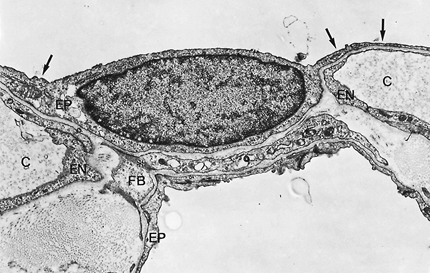 |
Fig. 3-12. Type I alveolar cell with thin cytoplasmic extensions (arrows) (8,600 magnification). C, alveolar capillary; EN, endothelial cell lining of capillary; EP, squamous alveolar epithelial cells; FB, fibroblast process with an intracytoplasmic bundle of contractile filaments (*). |
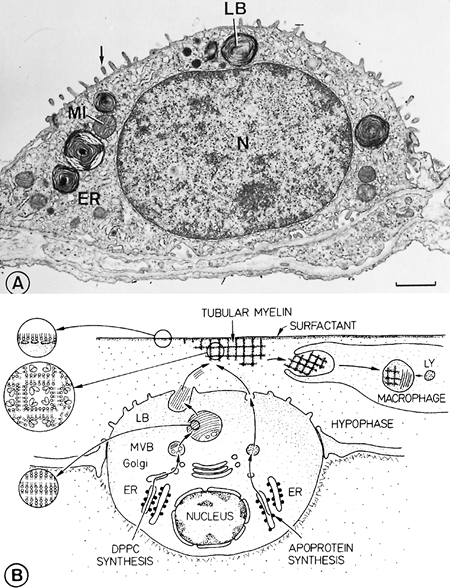 |
Fig. 3-13. A. In a type II epithelial cell, the abundant cytoplasm surrounding the nucleus (N) contains the characteristic osmiophilic lamellar bodies (LB), which store surfactant, and a rich complement of organelles such as endoplasmic reticulum (ER) and mitochondria (MI). The surface membrane carries microvilli (arrow) and junctions (J) with neighboring type I cells. From Weibel ER: Design and structure of the human lung. In Fishman AP, ed. Pulmonary Diseases and Disorders. New York: McGraw-Hill, 1971. With permission. B. Diagram of pathways for synthesis and secretion of surfactant dipalmitoylphosphatidyl chlorine (DPPC) and apoproteins by a type II cell, and for their removal by macrophages and by recycling. Note the arrangement of phospholipids in the lamellar bodies, tubular myelin, and surface film. Dashed line depicts possible alternative route of apoprotein secretion. MVB, multivesicular body. Modified from Weibel ER: The Pathway for Oxygen. Cambridge: Harvard University Press, 1984. With permission. |
A third pneumocyte, the brush cell, was described by Meyrick and Reid (1968). In the rat, this cell can be found
P.36
in terminal bronchioles; it is, however, rare in the gas-exchange zone. The brush cell is characterized by a spray of rather thick and regular cylindrical microvilli at the surface and by thick bundles of microfibrils in the cytoplasm. Brush cells are large, but only a small part of their membrane reaches the epithelial surface. Similar cells occur in larger airway epithelia and in other organs also; their significance is still obscure.
Alveolar macrophages (dust cells) are the cells of the alveolar lining layer (see Fig. 3-12). They are large cells exhibiting many vacuolar inclusions and lysosomes. Most of their phagosomes are filled with dark, lipid-rich inclusions. In their functional location, they are closely apposed to the alveolar epithelial surface and are submersed under the surfactant film of the lining layer (see Fig. 3-11); their bodies are in depressions of the alveolar wall, and they send out large extensions. In conventional histologic preparations, they have been removed from their original position on the alveolar wall; they appear to float in the alveolar space, and their surface is generally rounded off so that they acquire the appearance of large, spherical cells. Contrary to previous views that alveolar macrophages are derivatives of the epithelium, it has been shown convincingly that they derive from blood monocytes.
Interstitium
The interstitium is the space between the basal laminae of alveolar epithelium and capillary endothelium (see Fig. 3-9). It contains connective tissue and interstitial fluid. The connective tissue comprises cells, fibers, and amorphous substance containing proteoglycans, allegedly in a gel matrix. The distribution of connective tissue can vary considerably. In places where the air blood barrier is thin, connective tissue may be reduced to a few isolated, fine fibrils or may even be absent, in which case the adjoining basement membranes fuse. These latter regions are particularly important for gas exchange. In lung edema, they usually are not widened by interstitial fluid and can therefore be called restricted, as opposed to those unrestricted, thicker portions of interstitium between capillaries, where interstitial fluid can accumulate under pathologic conditions. The interstitial fibroblasts have been demonstrated to contain contractile filaments (see Fig. 3-12), so that Kapanci (1976) and co-workers (1974) suggested that they could regulate blood flow through the alveolar septum. In view of the interstitial structure described, one of us (ERW) and Bachofen (1979) proposed an alternative function for these cells: They could control the compliance of the unrestricted interstitial regions by regulating the width of the septum. In the postnatal rat lung, the interstitial cells form two distinct populations of cells: a lipid-containing and a non lipid-containing type. The lipid droplets of the lipid-containing type disappear, however, before weaning; the fate of the lipid-containing type remains unclear, according to Maksvytis and co-workers (1984). Lymphatic vessels are never found in alveolar septa. Nevertheless, a continuous path of the interstitial fluid toward the lymphatics of the subpleural space and of the peribronchial and perivascular connective sheaths has been postulated; the fluid probably follows connective fibers.
Endothelium
The endothelial cells form a capillary wall that is similar in structure to the endothelium in some other organs (Fig. 3-14; see Figs. 3-9 and 3-10). The cells form thin cytoplasmic extensions and hence resemble the alveolar epithelial cells of type I. A single cell covers between 1,000 and 1,500 m2 of the capillary lumen. Lung capillaries have no fenestrations. Further details are discussed subsequently.
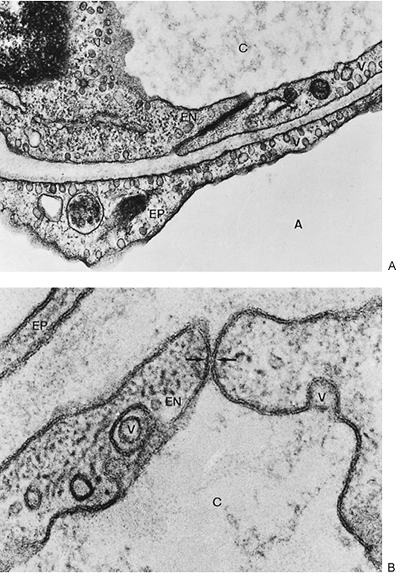 |
Fig. 3-14. A. Air blood barrier showing thin cytoplasmic extensions of alveolar epithelium type I (EP) and endothelial cells (EN) with intercellular junction. Note abundance of pinocytotic vesicles (V) (37,000 magnification). B. High-power view of junction between two capillary endothelial cells. The triple-layered structure of the cell membranes is apparent. In the junction, the membranes are closely apposed over a short stretch (arrows). Note pinocytotic vesicles (V) (184,800 magnification). A, alveolus; C, capillary. |
P.37
Extracellular Lining Layer and Pulmonary Surfactant
On the basis of theoretic considerations, as early as 1929, von Neergaard predicted that the alveolar surface must be lined by a layer of surface-active fluid, now commonly called pulmonary surfactant. It is an essential element, ensuring the stability of the air-filled lung. Its basic characteristics are twofold: first, it lowers the surface tension at the air liquid interface of the alveoli; and second, its surface tension is variable with the degree of inflation of alveoli.
Morphologic demonstration of pulmonary surfactant is possible only with the electron microscope. In routine preparations, usually no traces of this material are found (see Fig. 3-9). In lungs fixed by vascular perfusion, an extracellular duplex lining layer on the alveolar surface can be preserved (see Fig. 3-10), which two of us (JG and ERW) (1969, 1971) supposed to contain the alveolar surfactant system fixed in situ. Much of this material forms pools in pits and irregularities of the alveolar wall, which smooths it out. These pools are polymorphous. Sometimes they are of moderate electron density with dark specks, or they may contain lipid micelles or tubular myelin, a liquid crystal made up of surface active lipoproteins.
The synthesis and secretion of pulmonary surfactant are the functions of the type II pneumocytes. Figure 3-13B shows how the organelles of this cell are involved in synthesizing, storing, and secreting the surfactant phospholipids and the specific apoproteins. The single most abundant component of surfactant is the phospholipid dipalmitoyl phosphatidylcholine. Four major proteins have been identified in alveolar surfactant. Two of these, SP-A and SP-D, are hydrophilic and members of the lectin superfamily, associated with immunoglobulins. SP-A strongly binds phospholipids, whereas SP-D does not; both are not only actively involved in lowering surface tension but also immediately associated with phospholipids, but the clarification of their exact roles is proving to be difficult, as noted by Johansson and Curstedt (1997). It appears that tubular myelin figures (see Fig. 3-11) are an extracellular reserve form of surfactant, which can spread on the surface when alveoli enlarge. For further details and references, see Weibel (1985), Mason and Williams (1991), and Hawgood (1991). As shown by one of us (JG) and Reiss (1973), the availability of Ca2+ is crucial for the stability of tubular myelin as a recognizable morphologic structure.
Fine Structure of Pulmonary Blood Vessels
Alveolar Capillaries
The dense capillary network (see Fig. 3-8) that is intercalated between adjoining alveoli and forms part of the interalveolar septa is lined by an uninterrupted endothelial cell layer (see Fig. 3-9). Characteristically, these endothelial cells are formed of two parts: (a) a region of cytoplasm surrounding the nucleus and containing the most cellular organelles, such as mitochondria, endoplasmic reticulum, Golgi's complex, and various granules; and (b) thin cytoplasmic extensions, which are 0.1 m thick and virtually free of organelles. In the thinnest regions (less than 0.1 m), they are composed of two cell membranes and some intercalated cytoplasm (see Fig. 3-9); the portions of average thickness contain numerous pinocytotic vesicles that are, in part, attached to either of the cell membranes (see Figs. 3-9 and 3-14). These vesicles are involved in the transport of materials, mainly of proteins, across the endothelial cell. In connection with passage of macromolecules, the main problem, however, is the different permeability between endothelium and epithelium. General agreement exists that the epithelium represents the chief permeability barrier of the lung. Endothelium can be permeated under a variety of circumstances. The explanation for this difference was provided by comparative freeze-fracture studies of endothelial versus epithelial junctions. The epithelial tight junctions consist of a continuous network of three to five interconnected ridges and grooves; the endothelial junctions have only one to three rows of particles, with few interconnections and even some discontinuities, as discussed by Schneeberger (1991). Because it is believed that an inverse correlation exists between the number of strands constituting a tight junction and its permeability, it follows that epithelial junctions are tight, whereas endothelial junctions are relatively leaky.
Alveolar capillaries are associated with pericytes. Pericytes seem to be less frequent in the alveolar capillaries than in the systemic capillaries and less densely branched. Their function is still debated: they are supposed to be contractile cells. In normal lungs they are -smooth muscle and positive for actin, but negative for smooth muscle myosin heavy chain and desmin. Under pathologic conditions, they appear to acquire the immunocytochemical characteristics of smooth muscle cells as reported by Nehls and Drenckhahn (1991).
Ultrastructure of Larger Pulmonary Vessels
The endothelial lining of pulmonary arteries and veins differs from that of alveolar capillaries in that the cytoplasmic extensions are thicker (Fig. 3-15). They are likewise rich in pinocytotic vesicles and may contain numerous cellular organelles. These endothelial cells also contain a characteristic rod-shaped granule (Fig. 3-16) known to occur in all vascular endothelia of all vertebrate species as originally described by one of us (ERW) and Palade (1964). In the mammalian vascular system, these organelles are particularly numerous in medium-sized and larger branches of pulmonary arteries and veins, whereas they occur less frequently in systemic vessels of the same size. Based on indirect evidence, two of us (PHB and ERW) (1968) proposed that these organelles contain a procoagulative substance.
P.38
This assumption proved to be correct. Wagner and associates (1982) and Warhol and Sweet (1984), using immunocytochemical techniques, demonstrated that the endothelial-specific organelles contained factor VIII related antigen, also called von Willebrand factor. More recently, Bonfanti and colleagues (1989) and McEver and colleagues (1989) showed that the granule membrane carries the leukocyte-binding protein P selectin, also found in the -granules of platelets.
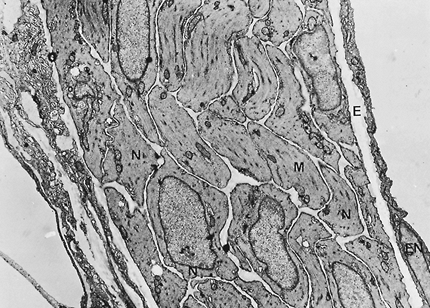 |
Fig. 3-15. Electron micrograph of longitudinal section of medium-sized pulmonary artery of muscle type. The endothelium (EN) lies over a strong elastic membrane (E). The smooth muscle fibers (M) are obliquely sectioned; their cytoplasm shows a fine filamentous structure. Some muscle cells (labeled N) show intercellular contacts (nexus), serving spread of excitation among the cells (5,850 magnification). |
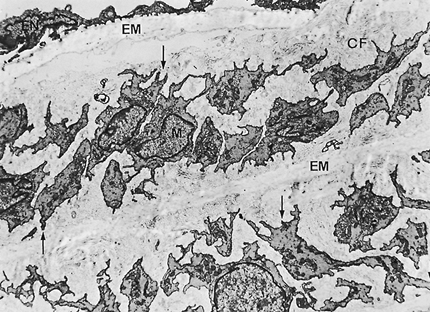 |
Fig. 3-16. Electron micrograph of pulmonary artery of elastic type. Note three strong elastic membranes (EM), paralleling the endothelium (EN), and ramified smooth muscle cells (M), which take an oblique course reaching from one elastic membrane to the next (arrows). The direction of muscle fibers alternates from one layer to the next. Collagen fibrils (CF) are abundant and mixed with elastic fibers (4,850 magnification). |
The electron microscopic study of intima and media of pulmonary vessels does not reveal many features that are not manifest by light microscopy. The circular smooth muscle cells of peripheral vessels of the muscular type are long, slender, and rather densely arranged (see Fig. 3-15). In elastic vessels (larger pulmonary arteries), the connective tissue elements prevail (see Fig. 3-16); the space between the prominent elastic laminae contains much collagenous tissue and relatively short smooth muscle cells, which extend from one elastic lamina to the next in an oblique course and appear to insert on the elastic laminae with ramified ends (see Fig. 3-16). In Fig. 3-17, a portion of a longitudinal section of a medium-sized pulmonary vein is shown; its thin wall is made up of an endothelium, a few irregularly arranged smooth muscle fibers, and collagenous as well as elastic fibers. One interesting feature is that smooth muscle cells of these vessel walls not only form close intercellular contacts in the form of patches or nexus (see Figs. 3-15 and 3-16) but also have close cell-to-cell contact with endothelial cells by means of short extensions across the internal elastic membrane (see Fig. 3-17). It is assumed that cell-to-cell contacts between endothelial or epithelial cells and
P.39
smooth muscle or interstitial cells are important in inducing and regulating various cell functions.
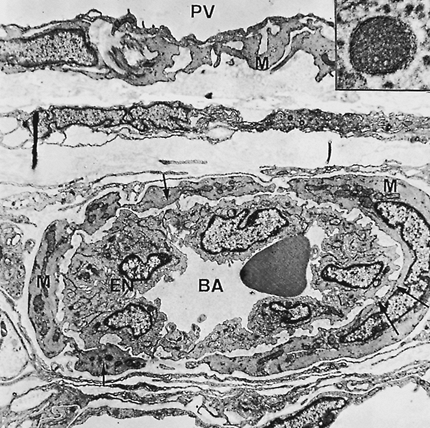 |
Fig. 3-17. Bronchial arteriole (BA) in a semicontracted state with thick endothelium (EN) and a simple layer of smooth muscle cells (M). Note numerous contacts between endothelial and muscle cells (arrows). At top, note the section of wall of small pulmonary vein (PV) with loose smooth muscle layer (M) and endothelium (4,850 magnification). Inset shows sample of specific endothelial organelles (also called Weibel-Palade bodies) at higher power. Note membrane and internal tubules (83,200 magnification). |
Bronchial Vessels
The arteries of the bronchial wall are of the muscle type. Figure 3-17 shows a small bronchial arteriole with one layer of circular smooth muscle and typically thick endothelial layer. Note the many contacts between muscle and endothelial cells. Bronchial arteries are often characterized by intimal longitudinal smooth muscle bundles that one of us (ERW) (1959) found to be related to the stretch strain to which these vessels are frequently exposed rather than to a special regulatory function.
MORPHOMETRY OF THE LUNG
The application of morphometric methods in analyzing lung tissue has yielded new insights into lung structure and its dimensions and has opened the possibility of a morphologic approach to the study of lung function.
Compartmental Distribution of Lung Volume
Any morphologic analysis of the functional capacity of the gas-exchange apparatus involves exact knowledge of the total lung volume and of its compartmental distribution.
To illustrate the distribution of the lung volume among the various zones and constituents, we consider the lung of a medium-sized adult inflated to about three fourths of total lung capacity; the total lung volume would then amount to about 5.7 L. Table 3-2 gives the approximate distribution of this volume among the lung compartments as derived from morphometric analysis of fixed lungs. The greatest compartment is the air space, of which about two thirds is in alveoli and only a small fraction in conductive airways, representing the anatomic dead space.
Table 3-2. Approximate Distribution of Total Lung Volume in Milliliters for Adult Human Lung at Three-fourths Total Lung Capacitya | ||||||||||||||||||||||||||||||||||||||||||||||||||||||||||
|---|---|---|---|---|---|---|---|---|---|---|---|---|---|---|---|---|---|---|---|---|---|---|---|---|---|---|---|---|---|---|---|---|---|---|---|---|---|---|---|---|---|---|---|---|---|---|---|---|---|---|---|---|---|---|---|---|---|---|
| ||||||||||||||||||||||||||||||||||||||||||||||||||||||||||
Number and Size of Alveoli and Capillaries
Alveoli
Despite its ability to supply the organism with enough oxygen, the lung of the newborn is still immature structurally. Besides primitive air sacs, which have often been misinterpreted as alveoli, only a fraction of the final number of alveoli is present at birth. One of us (PHB) (1974) and co-workers, including ERW (1974), as well as Kauffman and two of us (PHB and ERW) (1974), studied the postnatal development of alveoli using the rat lung as a model. It showed that alveoli were formed by outgrowth of new, so-called secondary septa from the sides of the primary ones present at birth. This occurrence transformed the smooth-walled channels and saccules of the newborn lung into alveolar ducts and alveolar sacs. This process was followed by an important remodeling of the septal structure. Indeed, in contrast to the mature septum containing a single capillary network interlaced with a fibrous skeleton, the primary and secondary septa presented a three-layered structure: A capillary network was found on both sides of a thick central sheet of connective tissue. The restructuring now consisted of a massive reduction of the interstitial tissue, probably accompanied by fusions of capillary segments. Zeltner and co-workers (1987) and Zeltner and one of us (PHB) (1987) obtained similar findings in studies on human lung growth. At about 1 month of age, a human lung compared well structurally with the lung of a 1-week-old rat. Although alveolar formation in humans starts during late fetal life, according to Langston and co-workers (1984), more than 80% of all alveoli are formed postnatally. After alveolization, the septal structure is altered in much the same way as in the rat lung: a remodeling of the parenchymal microvasculature has reduced the double capillary network
P.40
to a single one. Figure 3-18 summarizes the findings of these studies and proposes a new staging and timing of lung development and growth. It appears that alveolization proceeds at a faster pace than assumed so far. Bulk alveolar formation appears to be terminated at about 1.5 years of age. It is further accompanied and followed, respectively, by a stage of microvascular maturation lasting from a few months after birth to the age of 2 or 3 years. This statement does not preclude that after the phase of obtrusive rapid alveolization, some further alveoli may be added at a much slower pace in immature regions and at the uttermost periphery of the lung parenchyma. One of us (ERW) (1963) found that, in the adult, the number of alveoli averages 300 million. According to Angus and Thurlbeck (1972), the number is related to body length and may vary largely between 200 and 600 million.
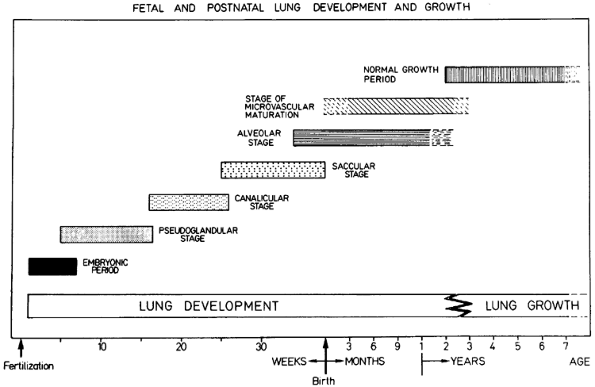 |
Fig. 3-18. Stages and timing of human lung development. Open-ended bars indicate that the exact start and end of the stages are still unknown. From Zeltner TB, Burri PH: The postnatal development and growth of the human lung. II. Morphology. Respir Physiol 67:269, 1987. With permission. |
For a lung of an adult inflated to three fourths of its maximal volume, one of us (ERW) (1963) found that the average alveolar diameter lies between 250 and 290 m. Glazier and associates (1967), however, demonstrated on dog lungs that alveolar size is not identical in all parts of the lung, but that in an erect lung, the upper parts contain larger alveoli than the dependent parts, because of the weight of the lung tissue.
Capillaries
As shown previously, capillaries form a dense network spreading over the surface of alveoli (see Fig. 3-8). This network is made up of hexagonal meshes, which means that usually three capillary segments are connected to each other at a junction point. The capillary network seems to be continuous over many interalveolar facets, perhaps even over a whole lobule or more. Terminal branches of arteries and veins connect to this vast network at points separated by about 5 mm. This determines microvascular fields that are about 0.5 mm in diameter and function like capillary microperfusion units but are not clearly demarcated by anatomic boundaries. In a morphometric analysis of eight normal human lungs by Gehr and co-workers (1978a), the total capillary volume varied between 125 and 387 mL (mean, 213 mL) and the capillary surface area from 74 to 189 m2 (mean, 126 m2).
During lung growth, capillary volume showed the steepest increase among all the parameters relevant for gas exchange. During the first 6 months, capillaries held only 22% of the volume of the interalveolar septa; this value reached 42% in adult lungs, according to Zeltner and co-workers, including one of us (PHB) (1987). Between 1 month of age and adulthood, capillary volume increases about 35 times and capillary surface area about 20 times in the human lung. With the capillary density being about equal, new capillaries have to be continuously added to the existing network. Caduff, Fischer, and one of us (PHB) (1986), and one of us (PHB) and Tarek (1990), demonstrated by scanning electron microscopy and by ultrastructural analysis of serial sections that the pulmonary capillary network grows by formation of new intercapillary meshes rather than by sprouting new capillaries. The process has been termed by Patan and associates (1992) intussusceptive microvascular growth(growth within itself), in analogy to the growth of cartilage. It consists in the formation of transcapillary tissue pillars that divide existing capillary segments. The newly formed and originally small individual tissue pillars (diameter less than 1.5 m) subsequently increase in diameter and thus give rise to new intercapillary meshes. In the meantime, Patan and co-workers, including one of us (PHB) (1992, 1996, 1997), could demonstrate various modes of pillar formation in intussusceptive growth and also prove that intussusceptive microvascular growth is not only present in the lung but also represents a widespread and fundamental angiogenic process in vascularized organisms. This new angiogenic mechanism also has been demonstrated in tumor growth by Nagy and co-workers (1995).
Gas Exchange Surface and the Air Blood Barrier
The alveolocapillary air blood barrier is composed of a surface-lining layer, epithelium, interstitium, and endothelium that have to be crossed by the oxygen molecules on their way from air to blood. The following dimensions of this barrier are of greatest importance for gas exchange: first, the surface area of air tissue interface; second, the surface area of tissue blood interface; and third, the thickness of the barrier and of its components.
The alveolar surface area of the adult human lung has been found to vary between 97 and 194 m2 (mean, 143 m2). This range is in contrast to previously published results, where by light microscopic morphometry, values between
P.41
70 and 80 m2 had been obtained. This discrepancy is because of the higher resolution of the electron microscope, which allows one to measure the complex free surface of the epithelial cells. With the light microscope, one could analyze only a smoothed surface of the alveolar wall.
In most species investigated, the total capillary surface area did not differ from the alveolar surface area by more than 10% to 15%. In the rat lung, the capillary-to-alveolar surface ratio is 1.05 to 1.1, which means that the capillary surface area of the rat lung is 5% to 10% higher than the alveolar surface. In the human lung and in the dog lung, where the capillaries are less dense, the quotient is about 0.88.
Thickness and Composition of the Alveolocapillary Barrier
From Fig. 3-9, it is evident that the width of the alveolocapillary barrier can vary from about 0.3 m to several microns. The thickness of this tissue barrier is important because it determines, together with other parameters, the diffusion resistance of the barrier that oxygen molecules moving from the alveolus to the capillary must overcome. This resistance is low in thin parts and higher in thick parts, so that the flux of gas at each point is inversely proportional to local barrier thickness. Hence, the thin parts of the barrier contribute most to gas exchange. In estimating an overall average thickness, this factor is best taken into account by determining the harmonic mean thickness of the air blood barrier, that is, the average of the reciprocal value of thickness, rather than the arithmetic mean, which estimates the tissue mass building the barrier. The arithmetic and harmonic mean thicknesses vary relatively little in various mammalian species. On average, the harmonic mean thickness is about one third of the arithmetic mean thickness. Estimates on human lungs give values of about 0.6 m for the harmonic mean barrier thickness, whereas the arithmetic mean thickness is about 2 m.
Morphometric Estimation of Diffusing Capacity
The term diffusing capacity of the lung (DL) has been introduced by physiologists, as noted by Forster (1964), to estimate the conductance of the pulmonary gas-exchange apparatus for gaseous diffusions between alveolar air and capillary blood. The physiologic definition uses Ohm's law and states that, for oxygen,
DLO2 = [V with dot above]O2/ Po2
in which [V with dot above]o2 is the O2 uptake and Po2 is the mean difference of O2 partial pressure between alveoli and capillaries.
It is implicit in the definition that a major part of DL is determined by structural properties of the lung, mainly by the available gas-exchange surfaces, by the thickness of the air blood barrier, and by the capillary blood volume. One of us (ERW) (1971) noted that refinements in morphometric methods have made it possible to estimate DL from measurements of lung structure performed on electron micrographs. To this end, the air hemoglobin barrier must be subdivided into three partial resistances or conductances that is, the reciprocal of the resistances, which are arranged in series, as shown in Figures 3-9 and FIG. 3-19. We then find DL from the sum of the partial resistances:

where Dt, Dp, and De are the diffusion conductances in tissue, plasma, and erythrocytes, respectively. This original model has been revised because it turns out that the tissue and plasma layers cannot be easily separated; they act as a single barrier because the flow of plasma past the tissue barrier is slow compared with O2 diffusion. In a new variant of the model, as described by one of us (ERW) and colleagues (1993), the total diffusion barrier thickness ( hb) is estimated as extending from the alveolar to the erythrocyte surface (see Fig. 3-19). Together with an estimate of membrane surface, this yields the so-called membrane-diffusing capacity (DM), which is combined with De to calculate DL. DL can be calculated if we measure the alveolar and capillary surface areas (Sa and Sc), the capillary volume (Vc), and the harmonic mean thickness of the total barrier ( hb). In addition, we need to know appropriate values for the physical coefficients of permeability ( D) and of the rate of O2 binding by the blood ( O2). Table 3-3 presents the results obtained by Gehr and associates (1978a) and one of us (ERW) with co-workers (1993) in a morphometric study of adult human lungs. Using most reasonable estimates of the physical coefficients, one of us (ERW) (1984) found DLO2 to amount to about 170 mL O2/min per mm Hg.
For comparison, the currently available or accepted physiologic values of DL at rest amount to about 30 mL O2/min per mm Hg. This value is hence far below the morphometric estimates. It should be noted that two different
P.42
things are measured: Morphometry estimates the size of the gas-exchange apparatus that is maximally available for gas exchange. Its values refer to a fully expanded lung. This can lead to an overestimation of DL by as much as 25% to 50% because one of us (JG) and associates (1979) showed that in lungs inflated with air and fixed by vascular perfusion, parts of the diffusion barrier are folded away from the surface even at highest inflation and thus do not contribute to gas exchange. Furthermore, we suppose that a gradient from air to blood exists at every point along the alveolar capillary. Under resting conditions, this is most certainly not the case; in fact, it is probable that the capillary blood is saturated before it leaves the capillary, as Karas and associates (1987) showed for the lungs of animals performing heavy exercise. We would therefore expect that the physiologic estimates of DL at rest should amount to only 20% to 40% of the maximal or true diffusing capacity. That this reasoning is probably correct is shown by the findings of Bitterli and co-workers (1971) in humans that, in exercise, physiologic estimates may yield values of DL between 70 and 100 mL O2/min per mm Hg. The morphometric estimate of pulmonary diffusing capacity in humans is therefore about two times larger than the physiologic estimate. One of us (ERW) and colleagues (1983) confirmed this difference by direct measurement of the physiologic and morphometric values of DL in animals. We concluded from this that the lung provides a gas-exchange apparatus that is large enough to allow O2 to diffuse to the blood in sufficient quantity when O2 consumption is elevated becaues of work. Destruction of lung tissue, as occurs in emphysema, would tend to reduce the true diffusing capacity by reduction of the gas-exchange surfaces and, possibly, by thickening of the barrier.
 |
Fig. 3-19. Model for estimating pulmonary diffusing capacity from physiologic (left) and morphometric information (right). |
Table 3-3. Basic Morphometric Parameters and Diffusing Capacity in Human Lung | |||||||||||||||||||||
|---|---|---|---|---|---|---|---|---|---|---|---|---|---|---|---|---|---|---|---|---|---|
|
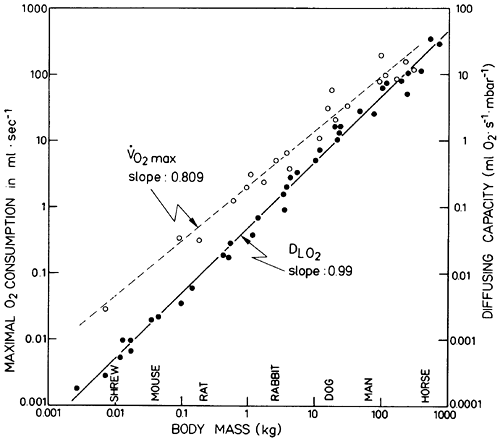 |
Fig. 3-20. The pulmonary diffusing capacity (full dots) and maximal O2 consumption (open circles) scale with body mass at a different slope on a double-logarithmic plot. From Weibel ER: The Pathway for Oxygen. Cambridge: Harvard University Press, 1984. With permission. |
Figure 3-20 shows the results of a comparative study of DL in mammalian species ranging from the smallest mammal, the Etruscan shrew, weighing only 2 g, to the horse. It is apparent that DL is related directly to body mass; in contrast, maximal O2 consumption, [V with dot above] O2 mass, varies with the 0.8 power of body mass. Consequently, the lung's capacity for O2 uptake is not matched to the body's need for O2 when one compares animals of different body size.
On the other hand, the lung can respond to increased O2 demands or to reduced environmental O2 at high altitude by enlarging the pulmonary diffusing capacity, as we (PHB and ERW) (1971), Hugonnaud (1977), and Gehr (1978b) and their colleagues showed. One of us (ERW) and colleagues (1987) found that athletic animals, such as dogs and horses, have a larger diffusing capacity than animals of the same size but lower O2 needs. The question of how the lung's morphometric properties are related to the body's O2 needs is still a matter of scientific debate, as one of us (ERW) (1984) and Taylor and co-workers (1987) noted. Furthermore, numerous reports indicate that the perinatal and postnatal period of alveolization is a highly sensitive phase susceptible to disturbances induced by environmental, chemical, and hormonal factors. In particular, it was shown, first by Massaro and co-workers (1985) and then by others, that alveolization of the rat lung is seriously impaired by minute repeated postnatal doses of dexamethasone. Tschanz and co-workers, including one of us (PHB) (1995), demonstrated that glucocorticoids induced a precocious maturation of the lung microvasculature and, by this, prevented adequate septation of the peripheral air spaces, resulting in a lower number of alveoli.
Morphometry of Conducting and Transitory Airways and Blood Vessels
Figure 3-21 shows a plastic cast of a human lung; in the right lung, only the airways have been modeled, whereas in the left lung, pulmonary arteries and veins have been demonstrated also. It is apparent that the airways branch toward the periphery by systematically dividing in two that is, by dichotomy. This dichotomy, however, is not regular; the two branches arising from a parent branch may differ considerably in both length and diameter. This is called irregular dichotomy.
P.43
Figure 3-22 shows a similar cast of an acinus from a human lung in which the casting material, silicon rubber, has filled the airways to the most peripheral alveoli. On such preparations, Haefeli-Bleuer and one of us (ERW) (1988) showed that the most peripheral airways, the respiratory bronchioles, and alveolar ducts also branch by irregular dichotomy.
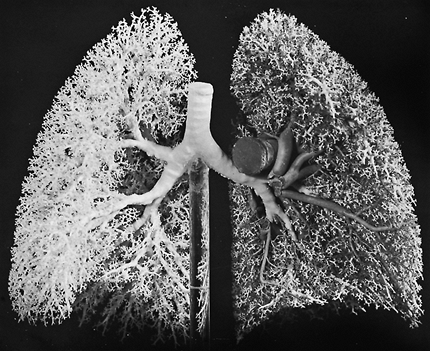 |
Fig. 3-21. Cast of human lung, showing airways in right lung and pulmonary arteries and veins in left lung. Note irregular dichotomy of all branches. |
The pattern of dichotomous branching provides a scheme with respect to which the systematic progression of the increase in the number of branches and of the reduction in dimensions can be described. If we first disregard the irregularities, we can estimate the average number of generations necessary to provide a sufficient number of terminal airway channels to carry alveoli for gas exchange namely, alveolar ducts and sacs. One of us (ERW) (1963) alone and with Haefeli-Bleuer (1988) estimated this average number of generations at 23. Figure 3-6 shows that the first 16 generations are purely conducting airways, leading from the trachea to the terminal bronchioles. From generation 17 on, alveoli are progressively incorporated into the airway wall until, in the twentieth generation, the entire wall is occupied by them. On the basis of more recent information, the transition from terminal to alveolated bronchioles may occur at generation 14, so that a total of nine generations carry alveoli. It must be stressed that these are average values and that, because of the irregularity, airways terminate in alveolar sacs anywhere from about generations 15 to 30.
 |
Fig. 3-22. Scanning electron micrograph of a silicon rubber cast of a human pulmonary acinus. Part of the alveolar ducts have been trimmed off to show the transitional bronchiole (arrow) and the first few orders of respiratory bronchioles. Note that alveolar ducts and sacs are densely covered by alveoli (scale marker=1 mm). |
This irregularity becomes apparent if length and diameter of the bronchial branches are measured on casts. Nevertheless, average dimensions can be calculated from these size distributions. If the average diameters (d) are plotted semilogarithmically against generations (z) (Fig. 3-23), we find them to follow an exponential function, namely,
![]()
Therefore, with each generation, the average airway diameter is reduced by
![]()
, which, as pointed out by Thompson D'Arcy (1942), is known in hydrodynamics to be a function of optimal size relationship between parent and daughter branches. But Fig. 3-23 also reveals that the diameters of peripheral or transitory airways that are provided with alveoli do not fit on this function; they are considerably larger than one would expect from their position in the bronchial tree. This difference can be explained by their different
P.44
roles in conveying oxygen from ambient air to alveoli. In conducting airways, air is transported en masse that is, a solution of O2 in nitrogen is flowing through the tubes, and hydrodynamic principles prevail. Toward the periphery, however, O2 molecules have to advance toward the alveolar surface by diffusion in the gas phase, and this, as emphasized by Gomez (1965), requires a greater cross-sectional area of the peripheral airways.
 |
Fig. 3-23. Progressive reduction by cube root of one half of average diameter of conducting airways in regularized dichotomy model contrasts with the slow decrease of diameter of acinar airways with progressive generations of branching. Compare text. From Haefeli-Bleuer B, Weibel ER: Morphometry of the human pulmonary acinus. Anat Rec 220:401, 1988. With permission. |
From this detailed information, we can construct a first model of the lung that may be useful for some general considerations on the structure function relationship in the airway system. The model assumes regular dichotomy over 23 generations. Its most pertinent dimensional properties are given in Table 3-4. It may be noted that the anatomic dead space of 150 mL, as estimated by physiologic methods, is reached at about generation 16, which corresponds to terminal bronchioles.
Irregular dichotomous models also can be constructed. Figure 3-24 reveals the numbers of generations necessary to arrive at airways 2 mm in diameter as well as the distribution of distances from these branches to the trachea; these branches were located between generations 4 and 13 and were 18 to 31 cm from the root of the trachea. Each of these about 400 branches 2 mm in diameter leads through an average of 14 subsequent branchings until alveolar sacs are reached. The units of lung tissue that they supply have a volume of some 12 mL and contain about 740,000 alveoli each. This consideration of irregularity can be carried further, but one should refer to the original publications by one of us (ERW) (1963) and Haefeli-Bleuer and one of us (ERW) (1988) for additional information.
Table 3-4. Dimensions of Human Airway Model (Average Adult Lung with Volume of 4,800 mL at about Three-fourths Maximal Inflation) | ||||||||||||||||||||||||||||||||||||||||||||||||||||||||||||||||||||||||||||||||||||||||||||||||||||||||||||||||||||||||||||||||||||||||||||||||||||||||||||||||||||||||||||||||||||||||||||||||||||||||||||||||
|---|---|---|---|---|---|---|---|---|---|---|---|---|---|---|---|---|---|---|---|---|---|---|---|---|---|---|---|---|---|---|---|---|---|---|---|---|---|---|---|---|---|---|---|---|---|---|---|---|---|---|---|---|---|---|---|---|---|---|---|---|---|---|---|---|---|---|---|---|---|---|---|---|---|---|---|---|---|---|---|---|---|---|---|---|---|---|---|---|---|---|---|---|---|---|---|---|---|---|---|---|---|---|---|---|---|---|---|---|---|---|---|---|---|---|---|---|---|---|---|---|---|---|---|---|---|---|---|---|---|---|---|---|---|---|---|---|---|---|---|---|---|---|---|---|---|---|---|---|---|---|---|---|---|---|---|---|---|---|---|---|---|---|---|---|---|---|---|---|---|---|---|---|---|---|---|---|---|---|---|---|---|---|---|---|---|---|---|---|---|---|---|---|---|---|---|---|---|---|---|---|---|---|---|---|---|---|---|---|
| ||||||||||||||||||||||||||||||||||||||||||||||||||||||||||||||||||||||||||||||||||||||||||||||||||||||||||||||||||||||||||||||||||||||||||||||||||||||||||||||||||||||||||||||||||||||||||||||||||||||||||||||||
Different models of the airway tree have been proposed. Horsfield (1991) considers the airway tree as a system of confluent tubes originating in parenchymal airways and ending in the trachea; this minimizes the effects of branching irregularities but otherwise leads to the same conclusions on the physiologic effects of airway design. West and co-workers (1986) used the principles of fractal geometry to arrive at a different description of the airway branching pattern.
Another way of looking at airway design starts with the observation that the branching pattern of airways is similar at all levels from the main stems out to the peripheral bronchioles. This is an example of what is called scale-invariant self-similarity, and it results from lung development that progresses systematically by branching of the terminal tube combined with proportional growth of the airways, as demonstrated by Kitaoka (1996) in collaboration with two of us (PHB and ERW). Self-similarity is the basic feature underlying a geometry of nature, called fractal geometry, as
P.45
introduced by Mandelbrot (1977, 1983). The question obviously comes up: Are the airways designed like a fractal tree? If so, this would have interesting consequences on our interpretation of the relation between form and function in the lung as explored by one of us (ERW) (1991, 1997).
 |
Fig. 3-24. Distribution of airways of 2-mm diameter with respect to generation z and distance from larynx. Modified from Weibel ER: Morphometry of the Human Lung. Heidelberg: Springer, 1963, p. 126. With permission. |
The test for the fractal nature of the airway tree is to look at how the dimensions of the branches change along the tree. Self-similarity, or the scale-invariate constancy of proportions, leads to the prediction that the diameter of airways should be a power law function of the generation, as worked out by West and co-workers (1986). If the data plotted in Fig. 3-23 are replotted on a double logarithmic scale (Fig. 3-25), it is seen that the data swing around the double log regression line. From this type of analysis, performed on several species, West and co-workers (1986) concluded that the airways have the basic properties of a fractal tree; the deviation of the data points from the straight line relationship may well have to do with the irregularities of branching imposed by the fact that the shape of the lung is determined by the shape of the space available in the chest.
The most interesting virtue of a fractal tree is that it fills, with its tips, the space homogeneously and densely, as shown by Kitaoka and two of us (PHB and ERW) (1996). Furthermore, in an ideal fractal tree, the distance from each end tip to the origin is equal for all tips, irrespective of whether they are close to the origin or at the outermost corner. Because the lung can be conceived of as a fractal tree, we predict that the pathway length for ventilation from the trachea to all the end tips of the airway tree is about equal by basic design. Figure 3-24 shows that the distribution of these distances is quite narrow.
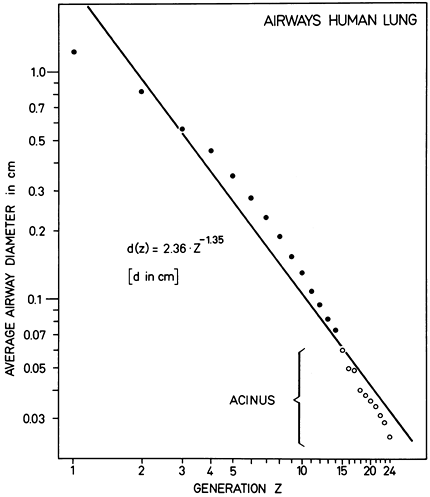 |
Fig. 3-25. The same data for airway diameter as in Fig. 3-23 plotted as a power law against generation to test for fractal nature of airways. From Weibel ER. Fractal geometry: a design principle for living organisms. Am J Physiol 261:L361, 1991. With permission. |
The blood vessels undergo, in principle, the same sequence of branching as the airways, with some differences in detail. Pulmonary arteries are topographically closely associated with the airways (see Fig. 3-21); down to the respiratory bronchioles, their branching would therefore seem to parallel that of the airways, but this is only partially true. It is well known that relatively large pulmonary arteries may send smaller branches to the capillary network of adjacent groups of alveoli. These accessory branches are called supernumerary arteries and cause, on the one hand, a more rapid progression of arterial branching and, on the other, greater irregularity in the arterial dimensions per generation.
At present, no extensive data on the morphometry of the pulmonary vascular tree are available. A preliminary model can be derived by comparing pulmonary arteries with airways and by determining the average generation number of dichotomous branching. The larger branches of the pulmonary artery, perhaps down to a 2-mm diameter and reaching to the eighth generation on the average, have dimensions
P.46
closely approximating those of the accompanying bronchi. In a first approximation, we may therefore use the measurements obtained on the bronchial tree to describe the major pulmonary arterial tree. We would therefore claim that these branches reduce their dimension with each generation to obey the hydrodynamic law of optimal size reduction described previously (see Fig. 3-23). Next, we may determine the total number of precapillaries that is, of the terminal arterial branches that lead into the capillary network and calculate from that the average generation number of dichotomous branching needed to reach this number; one of us (ERW) and Gomez (1962) found this to be on the order of 28 generations, hence about five generations more than the airways. The diameter of these precapillaries is between 20 and 30 m; if this range is plotted in Fig. 3-23, it falls on the function for dimensional reduction fitted to the major branches, which suggests that the pulmonary arterial tree reduces the dimension of its branches progressively following a hydrodynamic law for optimal reduction of diameters in a dichotomous branching system all the way out to the terminal branches. This seems logical because mass flow of blood occurs throughout, the diffusion of gases in the blood phase playing a negligible role for transport along the vessel axis. All this is highly conjectural, however, so long as it is not substantiated by more extensive actual measurement.
REFERENCES
Angus GE, Thurlbeck WM: Number of alveoli in the human lung. J Appl Physiol 32:483, 1972.
Bitterli J, et al: Repeated measurements of pulmonary O2 diffusing capacity in man during graded exercise. In: Scherrer M (ed): Pulmonary Diffusing Capacity on Exercise. Stuttgart: H Huber, 1971, p. 139.
Bonfanti R, et al: PADGEM (GMP140) is a component of Weibel-Palade bodies of human endothelial cells. Blood 73:1109, 1989.
Breeze RG, Wheeldon EG: The cells of the pulmonary airways. Am Rev Respir Dis 116:705, 1977.
Burri PH: The postnatal growth of the rat lung. III. Morphology. Anat Rec 180:77, 1974.
Burri PH, Dbaly J, Weibel ER: The postnatal growth of the rat lung. I. Morphometry. Anat Rec 178:711, 1974.
Burri PH, Tarek MR: A novel mechanism of capillary growth in the rat pulmonary microcirculation. Anat Rec 228:35, 1990.
Burri PH, Weibel ER: Beeinflussung einer spezifischen Cytoplasmischen Organelle von Endothelzellen durch Adrenalin. Z Zellforsch 88:426, 1968.
Burri PH, Weibel ER: Morphometric estimation of pulmonary diffusion capacity. II. Effect of PO2 on the growing lung. Respir Physiol 11:247, 1971.
Caduff, JH, Fischer LC, Burri PH: Scanning electron microscope study of the developing microvasculature in the postnatal rat lung. Anat Rec 216:154, 1986.
Crapo JD, et al: Cell numbers and cell characteristics of the normal human lung. Am Rev Respir Dis 126:332, 1982.
Dierynck I, et al: Potent inhibition of both human interferon-gamma production and biologic activity by the Clara cell protein CC16. Am J Respir Cell Mol Biol 12:205, 1995.
Dobbs LG: Pulmonary surfactant. Annu Rev Med 40:431, 1989.
Forster RE: Diffusion of gases. In: Fenn WD, Rahn H (eds): Handbook of Physiology, Section 3, Respiration. Vol. I. Washington, DC: American Physiological Society, 1964, p. 839.
Gehr P, Bachofen H, Weibel ER: The normal human lung: ultrastructure and morphometric estimation of diffusion capacity. Respir Physiol 32: 121, 1978a.
Gehr P, et al: Adaptation of the growing lung to increase [V with dot above]O2. III. The effect of exposure to cold environment in rats. Respir Physiol 32:345, 1978b.
Gil J, Reiss OK: Isolation and characterization of lamellar bodies and tubular myelin from rat lung homogenates. J Cell Biol 58:152, 1973.
Gil J, Weibel ER: Improvements in demonstration of lining layer of lung alveoli by electron microscopy. Respir Physiol 8:13, 1969.
Gil J, Weibel ER: Extracellular lining of bronchioles after perfusion-fixation of rat lungs for electron microscopy. Anat Rec 169:185, 1971.
Gil J, et al: Alveolar volume-surface area relationship in air- and saline-filled lungs fixed by vascular perfusion. J Appl Physiol 47:990, 1979.
Glazier JB, et al: Vertical gradient of alveolar size in lungs of dogs frozen intact. J Appl Physiol 23:694, 1967.
Gomez DM: A physico-mathematical study of lung function in normal subjects and in patients with obstructive pulmonary diseases. Med Thorac 22:275, 1965.
Haefeli-Bleuer B, Weibel ER: Morphometry of the human pulmonary acinus. Anat Rec 220:401, 1988.
Hawgood S: Composition, structure, and metabolism. In: Crystal RG, West JB (eds): The Lung Scientific Foundation. Vol. 1. New York: Raven Press, 1991, p. 247.
Hermans C, et al: Determinants of Clara cell protein (CC16) concentration in serum: a reassessment with two different immunoassays. Clin Chim Acta 272:101, 1998.
Horsfield K: Pulmonary airways and blood vessels considered as confluent trees. In: Crystal RG, West JB. (eds): The Lung Scientific Foundation. Vol. 1. New York: Raven Press, 1991, p. 721.
Hoyt RF Jr, McNelly N, Sorokin SP: Dynamics of neuroepithelial body (NEB) formation in developing hamster lung: light microscopic autoradiography after 3H-thymidine labeling in vivo. Anat Rec 227:340, 1990.
Hugonnaud C, et al: Adaptation of the growing lung to increased oxygen consumption. II. Morphometric analysis. Respir Physiol 29:1, 1977.
Jeffery PK: Morphologic features of airway surface epithelial cells and glands. Am Rev Respir Dis 128:14S, 1983.
Jeffery PK, Reid LM: The respiratory mucous membrane. In: Brain JD, Proctor DF, Reid LM (eds): Respiratory Defense Mechanisms. Part I. New York: Marcel Dekker, 1977.
Johansson J, Curstedt T: Molecular structures and interactions of pulmonary surfactant components. Eur J Biochem 244:675, 1997.
Kapanci Y: Location and function of contractile interstitial cells of the lungs. In: Bonhuys A (ed): Lung Cells in Disease. New York: Elsevier North-Holland, 1976, p. 69.
Kapanci Y, et al: Contractile interstitial cells in pulmonary alveolar septa: a possible regulatory of ventilation-perfusion ratio? Ultrastructural, immunofluorescence, and in vitro studies. J Cell Biol 60:375, 1974.
Karas RH, et al: Adaptive variation in the mammalian respiratory system in relation to energetic demand. VII. Flow of oxygen across the pulmonary gas exchanger. Respir Physiol 69:101, 1987.
Kauffman SL, Burri PH, Weibel ER: The postnatal growth of the rat lung. II. Autoradiography. Anat Rec 180:63, 1974.
Kitaoka H, Burri PH, Weibel ER: Development of the human fetal airway tree: analysis of the numerical density of airway endtips. Anat Rec 244: 207, 1996.
Langston C, et al: Human lung growth in late gestation and in the neonate. Am Rev Respir Dis 129:607, 1984.
Lauweryns JM, Cokelaere M: Hypoxia sensitive neuroepithelial bodies. Intrapulmonary secretory neuroreceptors modulated by the CNS. Z Zellforsch 145:521, 1973.
Low FN: Electron microscopy of the rat lung. Anat Rec 113:437, 1952.
Maksvytis HJ, et al: In vitro characteristics of the lipid-filled interstitial cell associated with postnatal lung growth: evidence for fibroblast heterogeneity. J Cell Physiol 118:113, 1984.
Mandelbrot BB: The Fractal Geometry of Nature. San Francisco: Freeman, 1977.
Mandelbrot BB: The Fractal Geometry of Nature. 2nd Ed. San Francisco: Freeman, 1983.
Mason RJ, Williams MC: Alveolar type II cells. In: Crystal RG, West JB (eds): The Lung Scientific Foundation. Vol. 1. New York: Raven Press, 1991, p. 235.
Massaro D, et al: Postnatal development of alveoli. Regulation and evidence for a critical period in rats. J Clin Invest 76:1297, 1985.
McEver RP, et al: GMP-140, a platelet -granule membrane protein, is also synthesized by vascular endothelial cells and is localized in Weibel-Palade bodies. J Clin Invest 84:92, 1989.
P.47
Meyrick B, Reid L: The alveolar brush cell in rat lung: a third pneumocyte. J Ultrastruct Res 23:71, 1968.
Nagy JA, et al: Pathogenesis of ascites tumor growth: angiogenesis, vascular remodeling, and stroma formation in the peritoneal lining. Cancer Res 55:376, 1995.
Nehls V, Drenckhahn D: Heterogeneity of microvascular pericytes for smooth muscle type alpha-actin. J Cell Biol 113:147, 1991.
Patan S, Haenni B, Burri PH: Implementation of intussusceptive microvascular growth in the chicken chorio-allantoic membrane (CAM). 1. Pillar formation by folding of the capillary wall. Microvasc Res 51:80, 1996.
Patan S, Haenni B, Burri PH: Implementation of intussusceptive microvascular growth in the chicken chorio-allantoic membrane (CAM). 2. Pillar formation by capillary fusion. Microvasc Res 53:33, 1997.
Patan S, et al: Intussusceptive microvascular growth: a common alternative to capillary sprouting. Arch Histol Cytol 55:65, 1992.
Plopper CG, Hyde DM, Buckpitt AR: Clara cells. In: Crystal RG, West JB (eds): The Lung Scientific Foundation. Vol. 1. New York: Raven Press, 1991, p. 215.
Schneeberger EE: Airway and alveolar epithelial cell junctions. In: Crystal RG, West JB (eds): The Lung Scientific Foundation. Vol. 1. New York: Raven Press, 1991, p. 205.
Sleigh MA: Mucus propulsion. In: Crystal RG, West JB (eds): The Lung Scientific Foundation. Vol. 1. New York: Raven Press, 1991, p. 189.
St. George JA, et al: An immunohistochemical characterization of Rhesus monkey respiratory secretions using monoclonal antibodies. Am Rev Respir Dis 132:556, 1985.
Sorokin SP, Hoyt RF Jr, Pearsall AD: Comparative biology of small granule cells and neuroepithelial bodies in the respiratory system: short review. Am Rev Respir Dis 128:26S, 1983.
Spicer SS, Schulte BA, Thomopoulos GN: Histochemical properties of the respiratory tract epithelium in different species. Am Rev Respir Dis 128: 20S, 1983.
Taylor CR, et al: Adaptive variation in the mammalian respiratory system in relation to energetic demand. VIII. Structural and functional limits to oxidative metabolism. Respir Physiol 69:117, 1987.
Thompson D'Arcy W: Growth and Form. New York: Cambridge University Press, 1942, p. 448.
Tschanz SA, Damke BM, Burri PH: Influence of postnatally administered glucocorticoids on rat lung growth. Biol Neonate 68:229, 1995.
Von Neergaard K: Neue Auffassungen ber einen Grundbegriff der Atemmechanik. Die Retraktionskraft der Lunge, abh ngig von der Oberfl chenspannung in den Alveolen. Z Gesamte Exp Med 66:373, 1929.
Wagner DD, Olmsted JB, Marder VJ: Immunolocalization of von Willebrand protein in Weibel-Palade bodies of human endothelial cells. J Cell Biol 95:355, 1982.
Warhol MJ, Sweet JM: The ultrastructural localization of von Willebrand factor in endothelial cells. Am J Pathol 117:310, 1984.
Weibel ER: Die Blutgef ssanastomosen in der menschlichen Lunge. Z Zellforsch 50:653, 1959.
Weibel ER: Morphometry of the Human Lung. Heidelberg: Springer, 1963.
Weibel ER: Morphometric estimation of pulmonary diffusion capacity. I. Model and method. Respir Physiol 11:54, 1971.
Weibel ER: The Pathway for Oxygen: Structure and Function in the Mammalian Respiratory System. Cambridge, MA: Harvard University Press, 1984, pp. 1 425.
Weibel ER: Lung cell biology. In: Fishman AP, Fisher AB (eds): Handbook of Physiology. Section 3, The Respiratory System. Vol. I. Bethesda: American Physiological Society, 1985, p. 47.
Weibel ER: Fractal geometry: a design principle for living organisms. Am J Physiol 261:L361, 1991.
Weibel ER: Design of airways and blood vessels considered as branching trees. In: Crystal RG, et al (eds): The Lung: Scientific Foundations. Vol. 1. 2nd Ed. Philadelphia: Lippincott-Raven Publishers, 1997, p. 1061.
Weibel ER, Bachofen H: Structural design of the alveolar septum and fluid exchange. In: Fishman AP, Renkin EM (eds): Pulmonary Edema. Bethesda: American Physiological Society, 1979.
Weibel ER, Gil J: Structure function relationship at the alveolar level. In: West JG (ed): Bioengineering Aspects of the Lung. New York: Marcel Dekker, 1977.
Weibel ER, Gomez DM: Architecture of the human lung. Science 137:577, 1962.
Weibel ER, Palade GE: New cytoplasmic components in arterial endothelia. J Cell Biol 23:101, 1964.
Weibel ER, et al: Maximal oxygen consumption and pulmonary diffusing capacity: a direct comparison of physiologic morphometric measurements in canids. Respir Physiol 54:173, 1983.
Weibel ER, et al: Adaptive variation in the mammalian respiratory system in relation to energetic demand. VI. The pulmonary gas exchanger. Respir Physiol 69:81, 1987.
Weibel ER, et al: Morphometric model for pulmonary diffusing capacity. I. Membrane diffusing capacity. Respir Physiol 93:125, 1993.
West BJ, Bhargava V, Goldberg AL: Beyond the principle of similitude: renormalization in the bronchial tree. J Appl Physiol 60:1089, 1986.
Wissel H, et al: SP-A-binding protein BP55 is involved in surfactant endocytosis by type II pneumocytes. Am J Physiol 271:L432, 1996.
Yao XL, et al: Interferon-gamma stimulates human Clara cell secretory protein production by human airway epithelial cells. Am J Physiol 247: L864, 1998a.
Yao XL, et al: Tumer necrosis factor-alpha stimulates human Clara cell secretory protein production by human airway epithelial cells. Am J Respir Cell Mol Biol 19:629, 1998b.
Zeltner TB, Burri PH: The postnatal development and growth of the human lung. II. Morphology. Respir Physiol 67:269, 1987.
Zeltner TB, et al: The postnatal development and growth of the human lung. I. Morphometry. Respir Physiol 67:247, 1987.
READING REFERENCES
Ballard PL: Hormones and Lung Maturation. Berlin: Springer, 1986.
Burri PH: Development and growth of the human lung. In: Fishman AP, Fischer AB (eds): Handbook of Physiology, Section 3, The Respiratory System. Vol. I. Bethesda: American Physiological Society, 1985, p. 1.
Burri PH: Development and regeneration of the lung. In: Fishman AP (ed): Pulmonary Diseases and Disorders. Vol. 1. New York: McGraw-Hill, 1988, pp. 61 78.
Burri PH: Postnatal development and growth of the pulmonary microvasculature. In: Motta PM, Murakami T, Fujita H (eds): Scanning Electron Microscopy of Vascular Casts: Methods and Applications. Boston: Kluwer Academic Publishers, 1992, pp. 139 156.
Gil J: Ultrastructure of lung fixed under physiologically defined conditions. Arch Intern Med 127:896, 1971.
Gil J: Models of Lung Disease. Vol. 47. New York: Marcel Dekker, 1990.
Murray JF: The Normal Lung. 2nd Ed. Philadelphia: WB Saunders, 1986.
Scarpelli EM, Mantone AJ: The pulmonary surfactant system. In: Robertson B, van Golde LMG, Batenburg JJ (eds): Pulmonary Surfactant. Amsterdam: Elsevier Science Publishers, 1984, p. 119.
Thurlbeck WM: Pathology of the Lung. New York: Thieme, 1988.
Von Hayek H: Die menschliche Lunge. 2. Auflage. Heidelberg: Springer, 1970.
Weibel ER: Functional morphology of lung parenchyma. In: Macklem PT, Mead J (eds): Handbook of Physiology, Section 3, The Respiratory System. Vol. III. Part 1. Bethesda: American Physiological Society, Bethesda, 1986, p. 89.
Weibel ER: Design of biological organisms and fractal geometry. In: Nonnenmacher T, Losa GA, Weibel ER (eds): Fractals in Biology and Medicine. Basel: Birkh user Verlag, 1994, p. 68.
Weibel ER: Symmorphosis: On Form and Function in Shaping Life. Cambridge MA: Harvard University Press, 2000.
EAN: 2147483647
Pages: 203
 cm3
cm3